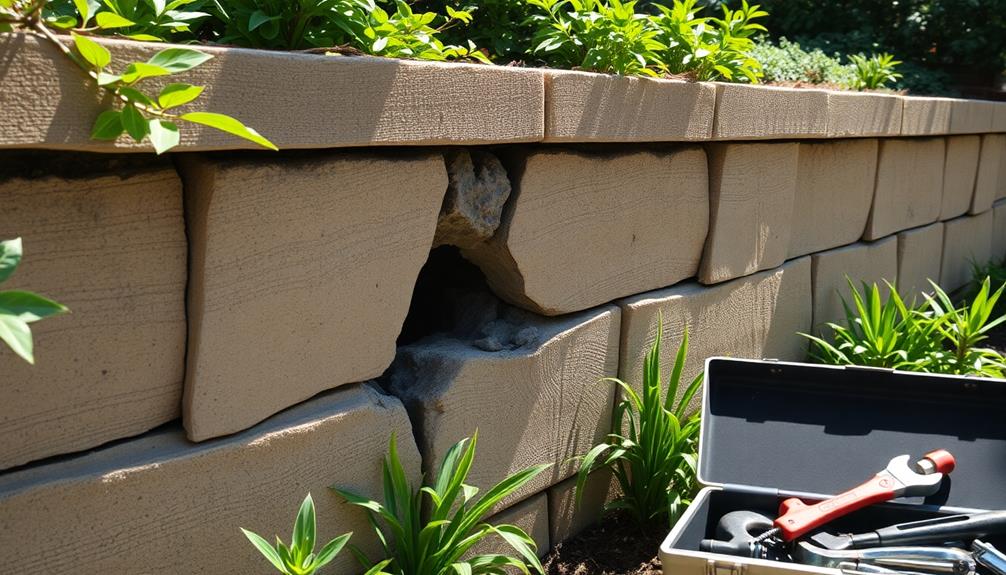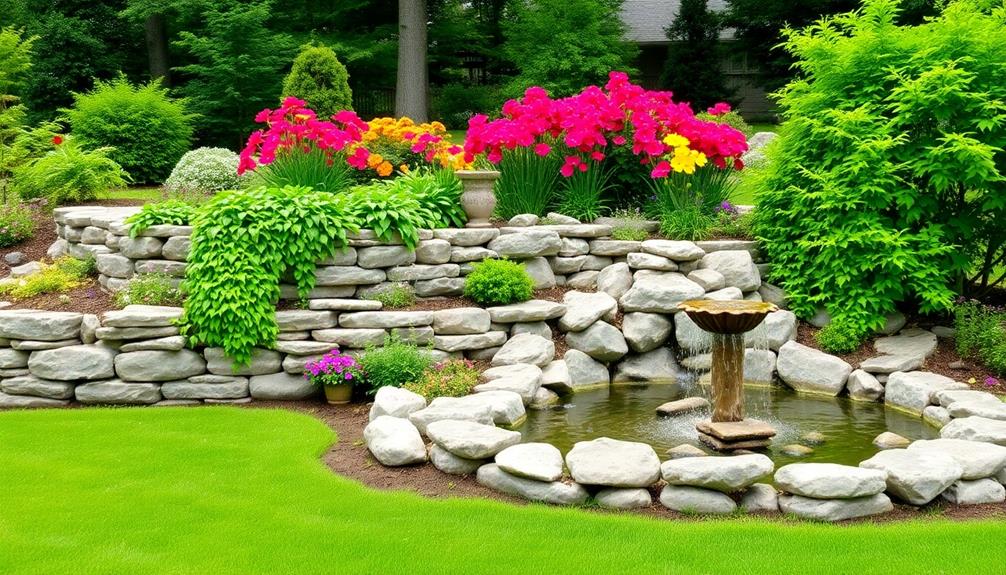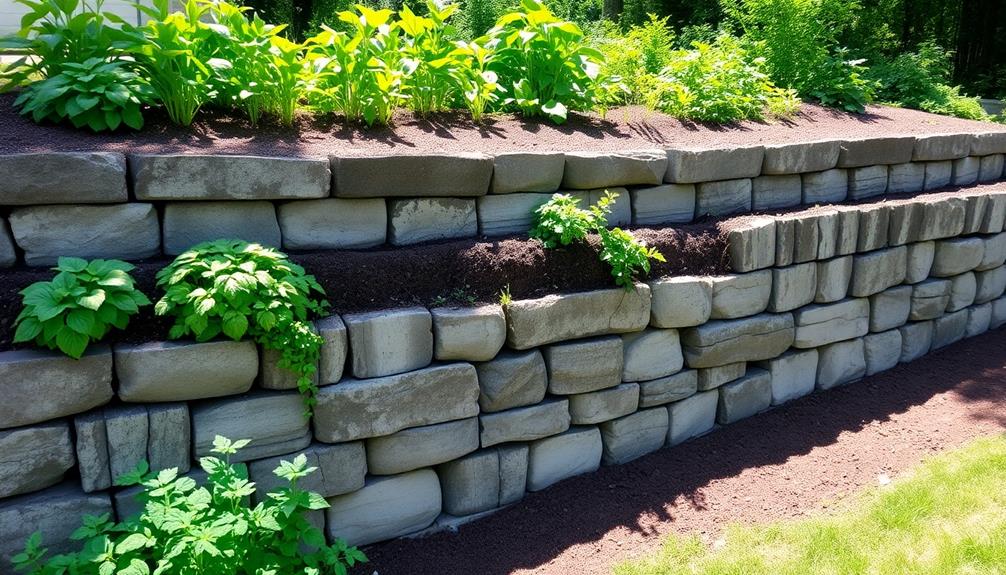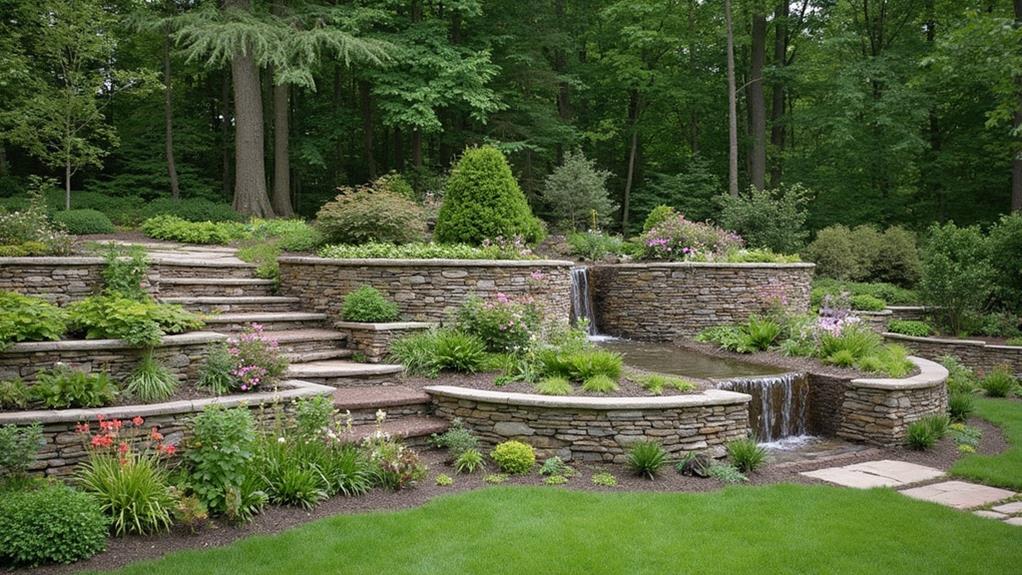Hiring a professional for retaining wall repairs is pivotal to preserving structural integrity and extending the wall's longevity. Experts provide in-depth evaluations of cracks, bulging, and load distribution issues, ensuring accurate diagnosis and tailored solutions. They employ advanced repair techniques, such as reinforcement and underpinning, to address both superficial and structural concerns, while ensuring compliance with safety standards and building codes. Professionals use high-quality materials suited to specific environmental conditions, reducing the risk of recurring problems and enhancing the wall's durability and aesthetic. Their expertise considerably reduces repair frequency and potential legal ramifications, offering a cost-effective long-term solution. Discover more about effective repair strategies and materials.
Table of Contents
ToggleWalls Contractor Highlights
- Professionals accurately diagnose problems and implement tailored solutions to ensure structural integrity and longevity.
- Access to quality materials and compliance with local regulations enhance wall durability and aesthetic appeal.
- Expert services minimize frequent repairs, providing a cost-effective long-term solution that preserves property value.
- Specialized equipment and project management skills ensure efficient, timely completion with minimal disruption.
- Professional repairs prevent safety issues and potential legal complications, protecting both the property and its inhabitants.
Retaining Wall Repair Explained

Retaining wall repair is a multifaceted process that begins with identifying structural issues such as cracks, bulging, or leaning, which can compromise the wall's integrity. It's important to understand that proper engineering and permitting are often required for complex retaining wall repairs, ensuring that solutions are tailored to specific challenges.
Various common repair techniques, including reinforcing with steel braces, underpinning, and installing tiebacks, are employed to restore and enhance the wall's stability. Additionally, ensuring proper drainage is essential to prevent water accumulation, which can exacerbate existing problems and lead to further deterioration of the wall structure.
Common Repair Techniques
When it comes to addressing issues with retaining walls, several common repair techniques are employed to restore their structural integrity and functionality. Among these, regrading stands out as a foundational method, aiming to manage water flow and prevent future erosion by adjusting the slope of the surrounding landscape. This technique often complements the installation of drainage systems, such as French drains or weep holes, which are indispensable in mitigating water pressure that can compromise a wall's stability.
Reinforcement is another widely used technique, involving the insertion of steel bars or geogrid materials to enhance a wall's strength. This approach is particularly effective for walls that have succumbed to lateral pressure or have begun to bulge. Additionally, underpinning can be utilized to stabilize the foundation, especially in cases where settling has weakened its support.
For aesthetic and minor structural issues, repointing is frequently applied, involving the renewal of mortar joints to preserve both the appearance and durability of masonry walls. In scenarios where sections of the wall have deteriorated beyond simple repair, partial reconstruction may be necessary, selectively replacing compromised components while salvaging the existing structure. These techniques underscore the importance of professional expertise in ensuring long-lasting solutions.
Identifying Structural Issues
Evaluating the structural integrity of a retaining wall is essential for timely and effective repairs. Identifying potential issues early can prevent further deterioration and costly interventions. Professionals adeptly assess common signs of distress such as cracks, bulges, or tilting, which may indicate underlying problems with the wall's foundation or the materials used. Such evaluations require a keen understanding of engineering principles and the ability to interpret subtle cues within the structure, ensuring homeowners are well-informed about their wall's condition.
A professional's expertise extends beyond surface observations; they investigate the intricacies of load distribution and soil interactions. They are equipped to recognize symptoms that might elude the untrained eye, such as differential settlement or signs of erosion. Their thorough analysis includes checking for gaps between wall segments and examining the wall's alignment with its intended design. Through these detailed inspections, they determine whether issues are superficial or symptomatic of deeper structural concerns.
Importance of Proper Drainage
Ensuring proper drainage is paramount in the maintenance and repair of retaining walls. The structural integrity of these walls is largely dependent on effective water management. Neglecting this aspect can precipitate a range of issues that may compromise the stability and longevity of the wall, fostering a sense of belonging and security within your community.
- Prevention of Hydrostatic Pressure: Accumulated water behind a retaining wall increases hydrostatic pressure, which can lead to bulging, cracking, or even complete structural failure. Proper drainage systems alleviate this pressure, preserving the wall's integrity.
- Minimization of Soil Erosion: Adequate drainage prevents the erosion of soil, which is essential for maintaining the ground's stability. Without it, the soil may shift, leading to an unstable foundation for the wall.
- Protection Against Freeze-Thaw Cycles: In colder climates, water trapped behind a wall can freeze and expand, causing damage to both the wall and its foundation. Effective drainage mitigates this risk by ensuring water is promptly removed.
- Longevity and Cost Efficiency: By implementing proper drainage, the lifespan of the retaining wall is extended, reducing the need for frequent repairs and associated costs, thereby ensuring the community benefits from lasting, reliable structures.
Benefits

Engaging professional services for retaining wall repairs brings numerous benefits, foremost among them being the guarantee of structural integrity through expert intervention. By evaluating site conditions and topography, professionals make certain that any repair work aligns with the specific needs of your landscape.
These professionals not only provide access to superior materials that enhance the wall's durability but also ensure that projects are completed efficiently, minimizing downtime. In addition, their expertise offers a cost-effective solution in the long run, as it mitigates the need for frequent repairs, ultimately safeguarding your investment.
Expertise Ensures Structural Integrity
By leveraging specialized knowledge and skills, expertise in retaining wall repairs is pivotal in maintaining structural integrity. Professionals bring a wealth of experience, understanding the intricate engineering principles that guarantee the longevity and stability of these structures. Their proficiency not only safeguards the physical form but also upholds the aesthetic harmony of your property.
- Accurate Problem Diagnosis: Experts can accurately identify underlying issues, such as soil erosion or drainage problems, which may not be apparent to the untrained eye. This guarantees that the root cause is addressed, preventing future complications.
- Tailored Solutions: With a deep understanding of various construction materials and methods, professionals craft solutions tailored to your specific environmental and structural needs, guaranteeing a customized approach that aligns with local regulations and standards.
- Enhanced Durability: Through precise engineering and quality workmanship, experts enhance the durability of the retaining wall, guaranteeing it withstands environmental pressures and time.
- Safety Assurance: Professionals adhere to stringent safety protocols, minimizing risks during repairs and guaranteeing the safety of your family and community.
Engaging a professional in retaining wall repairs fosters a sense of belonging, knowing that your property is in capable hands, and contributes to a secure and aesthetically pleasing environment.
Access to Quality Materials
Expertise in retaining wall repairs not only guarantees structural integrity but also provides access to quality materials, which is a significant advantage. Professionals in this field have established networks with suppliers, ensuring they source the best materials that meet industry standards. These connections allow them to procure specialized items that are often unavailable to the general public, thereby enhancing the durability and aesthetic appeal of the retaining wall.
The quality of materials used in repairs profoundly impacts the longevity and performance of a retaining wall. Professionals are well-versed in selecting materials that suit specific environmental conditions and soil types, ensuring the wall can withstand natural elements over time. By leveraging their expertise, they can recommend solutions that are tailored to individual needs, fostering a sense of trust and belonging among clients.
Moreover, professional repair services often include warranties on materials, offering peace of mind and long-term assurance. This commitment to quality not only reflects their dedication to excellence but also reassures clients of their investment's value. Ultimately, access to premium materials underscores the importance of hiring a professional, ensuring the wall's structural integrity and visual harmony within its surroundings.
Time-Efficient Project Completion
Efficiency is paramount when it comes to retaining wall repairs, as timely project completion minimizes disruption and mitigates potential issues associated with prolonged construction. Engaging professional services guarantees your project is executed with precision and swiftness, keeping your property accessible and functional.
Professionals bring a wealth of experience, allowing them to anticipate challenges and streamline processes that an untrained individual might overlook.
- Expertise and Skill: Trained professionals possess the technical know-how to quickly identify problems and implement solutions, accelerating the repair timeline without compromising quality.
- Access to Advanced Tools: Professionals utilize specialized equipment that enhances efficiency, enabling them to perform tasks more swiftly and accurately than standard tools would allow.
- Project Management: Experienced contractors effectively coordinate various aspects of the project, from securing permits to managing on-site activities, ensuring seamless progression and adherence to deadlines.
- Reduced Risk of Delays: Professionals are adept at foreseeing potential setbacks and devising contingency plans, vastly reducing the likelihood of unexpected delays.
Cost-Effective Long-Term Solution
A well-executed repair of a retaining wall serves as a cost-effective long-term solution, as the investment in professional services yields substantial benefits over time. By engaging skilled professionals, property owners are assured of not only immediate remediation of structural issues but also the implementation of preventative measures that extend the lifespan of the wall. Professionals bring a wealth of expertise, utilizing advanced techniques and materials that surpass DIY efforts, hence ensuring durability and resilience against environmental stressors.
Furthermore, professional repairs mitigate the risk of recurring problems, which could lead to more extensive and costly damage if left unaddressed. This foresight in maintenance ultimately translates to financial savings, as the need for frequent repairs is considerably reduced. In addition, a professionally maintained retaining wall enhances the aesthetic value and safety of the property, contributing to an increase in property value.
In essence, choosing a professional service for retaining wall repairs is an investment in peace of mind. The assurance that comes from knowing the job is expertly handled fosters a sense of belonging within a community committed to high standards of property upkeep, where each member contributes to the overall aesthetic and structural integrity.
Soil Erosion Prevention Tips

To effectively combat soil erosion in retaining wall environments, it is essential to implement a multifaceted approach that encompasses strategic plant selection, effective drainage solutions, and the application of mulching for stability. By integrating these elements, homeowners can considerably enhance the durability and longevity of their retaining structures while minimizing the risk of erosion-related damages. The table below provides a succinct overview of these critical components and their respective benefits:
| Strategy | Description | Benefit |
|---|---|---|
| Strategic Plant Selection | Utilizing deep-rooted vegetation to anchor soil | Enhances soil stability |
| Effective Drainage Solutions | Incorporating systems to manage water flow | Prevents water accumulation |
| Mulching for Stability | Applying organic or inorganic mulch layers | Reduces surface runoff |
Strategic Plant Selection
Strategic plant selection plays a pivotal role in preventing soil erosion around retaining walls. By carefully choosing the right plants, homeowners can enhance the structural integrity of walls while fostering a sense of community with the surrounding landscape. Appropriately selected plant species can stabilize soil, improve aesthetics, and contribute to a sustainable environment.
Root System Depth: Opt for plants with deep root systems, such as native grasses and groundcovers, which anchor the soil effectively. Their roots penetrate deeply, reinforcing soil cohesion and reducing erosion.
Climate Adaptability: Select species well-suited to the local climate. Native plants are particularly advantageous as they are better adapted to the regional weather patterns and require less maintenance, fostering a seamless integration with the existing ecosystem.
Growth Patterns: Consider plants with spreading growth habits. Low-growing shrubs and vines can create a natural barrier against soil displacement, offering a protective layer over the soil surface.
Biodiversity: Promote a diverse plant palette. A mix of species can enhance ecological stability and resilience, creating a dynamic and supportive environment that can withstand varying conditions and potential pests.
Effective Drainage Solutions
Addressing soil erosion effectively often hinges on implementing robust drainage solutions. In retaining wall repairs, making certain proper drainage is vital to maintaining the structural integrity of both the wall and the surrounding landscape. Water accumulation behind a retaining wall increases hydrostatic pressure, potentially leading to wall failure.
As a result, implementing effective drainage solutions such as perforated pipes and gravel backfill can noticeably alleviate these pressures. Perforated pipes, often situated at the base of the retaining wall, collect excess water and redirect it away from the wall structure. This method minimizes water-related stress, fostering a stable environment for the wall. Similarly, incorporating gravel backfill enhances drainage by allowing water to percolate through the material, reducing saturation of the soil directly abutting the wall. This combination creates an efficient drainage system that mitigates soil erosion.
Furthermore, integrating weep holes into the design can enhance drainage efficiency. Weep holes provide a direct outlet for trapped water, ensuring that moisture does not accumulate behind the wall. These solutions not only protect the wall but also contribute to the long-term health of the entire landscape. Engaging a professional ensures these methods are tailored specifically to the unique characteristics of your property, fostering a sense of security and belonging within your community.
Mulching for Stability
In addition to implementing effective drainage solutions, mulching serves as an essential method in preventing soil erosion and enhancing the stability of retaining walls. Mulching not only conserves moisture but also acts as a protective layer that mitigates the erosive force of rainfall, thereby playing a pivotal role in maintaining the integrity of your landscape. It offers a sustainable, eco-friendly approach and fosters a sense of community through shared environmental responsibility.
Erosion Control: Mulch reduces the impact of raindrops on bare soil, minimizing displacement and loss of soil particles that can compromise retaining wall structures.
Moisture Retention: By retaining soil moisture, mulch supports the growth of plant roots, which further stabilizes the soil around retaining walls, reducing risks of movement or slippage.
Temperature Regulation: Mulch acts as an insulating blanket, protecting the soil against extreme temperature fluctuations, which can affect soil structure and wall stability.
Aesthetic Enhancement: Beyond its functional benefits, mulch provides visual appeal, complementing the landscape and fostering a cohesive and welcoming outdoor environment.
Walls Contractor FAQ
How Much Does a Professional Retaining Wall Repair Typically Cost?
The cost for professional retaining wall repairs generally ranges from $50 to $150 per square foot, depending on the materials, complexity, and location. Involving skilled experts guarantees quality and safety, fostering a sense of community and trust.
How Long Does It Take to Repair a Retaining Wall Professionally?
The duration for professional retaining wall repairs varies based on factors like wall size, damage extent, and materials. Generally, it ranges from a few days to a week, ensuring quality and longevity, fostering trust and community assurance.
What Qualifications Should a Professional Retaining Wall Contractor Have?
A qualified retaining wall contractor should possess relevant certifications, extensive experience, and a strong portfolio of past projects. Additionally, expertise in soil mechanics, drainage solutions, and local building codes is pivotal for ensuring the wall's structural integrity and safety.
Can a Repaired Retaining Wall Add Value to My Property?
A repaired retaining wall can indeed enhance property value by improving structural integrity and aesthetic appeal. It contributes to landscape stability and can make a property more attractive and secure, fostering a sense of belonging and investment.
Are There Any Warranties or Guarantees Offered With Professional Retaining Wall Repairs?
Professional retaining wall repair services often provide warranties or guarantees, offering peace of mind and confidence in the quality of workmanship. These assurances foster trust and security within the community, ensuring a shared commitment to maintaining property integrity and value.







